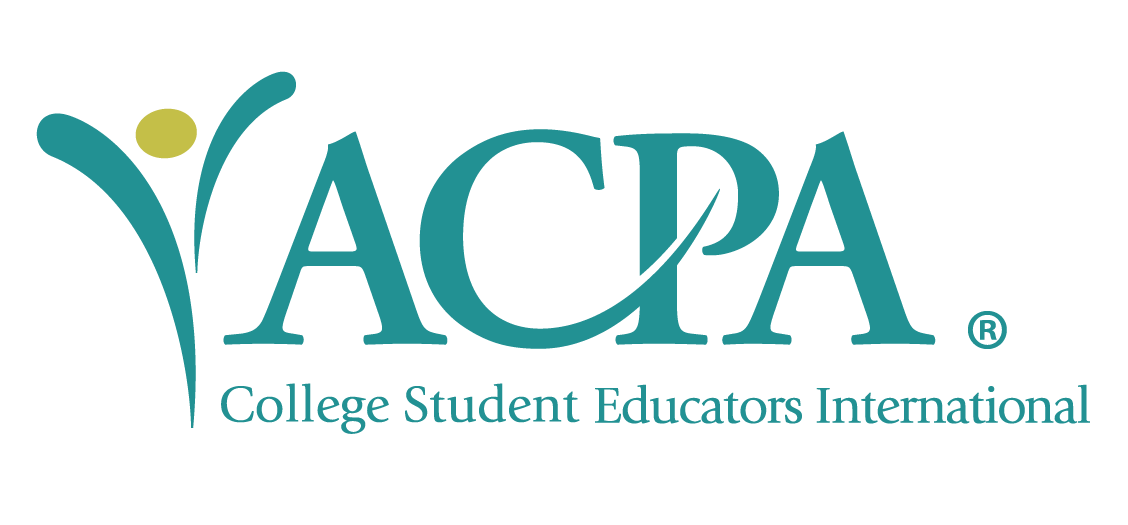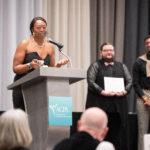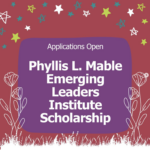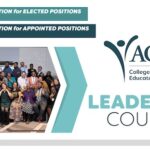By Naseeb K. Bhangal, Wardah Mohammed, Johanna Hughes, Javed Ahmed, , Tenzing Dolma, Diandra Sarr, & Hannah Honor
On what felt like one of the last days of summer in Chicago, I (Naseeb) frantically called up Wardah from the Back of the Yards coffee house patio to finalize the title and abstract for our ACPA scholarly session proposal. As a team of first-time qualitative researchers, we spent weeks prior to the proposal deadline requesting feedback from scholar mentors for our objectives, methodology, and other parts of our proposal but overlooked the title and abstract. Accepting the oversight as a rookie mistake, I was grateful that Wardah joined me over the phone to offer last-minute suggestions and support. We both remained on the call until I hit submit, and I let out a sigh of relief. While the submission marked a formal milestone for our project, we both celebrated a larger accomplishment, recalling how our collaborative autoethnography (CAE) group continues to write, commune, and think across three time zones, a pandemic, and individual timescapes (e.g., Adam, 2002). I felt an immense cloud of gratitude blanket me.
Our CAE team consists of seven individuals who share(d) involvement in an intergenerational and intersectional student affairs program for Women of Color (WOC) run by the office of student diversity and multicultural affairs at a predominantly White, Jesuit Catholic institution in the U.S. Midwest. Long before we considered researching our experiences with WOC identity and solidarity, all of us had been involved in the program as graduate or undergraduate students at some point, two of us were student affairs professionals responsible for overseeing the program, and three of us were student leaders hired to oversee monthly co-curricular efforts, such as the annual WOC Retreat and Alternative Break Immersion. Just as distinct as our formal roles were in the program, so too were the intersections we negotiated between structures of power at the institution and our individual social identities. Our distinct intersections and experiences within the WOC space drew us together and drove our curiosity and collaboration.
We find ourselves pondering a wide-range of questions, but the most urgent and repetitive among them include: When did we first come to learn about WOC identity? How do our understandings of WOC identity compare to the understandings of WOC subjectivity formulated through the political efforts of U.S. activists between the early 1960s and the late 1980s? Do we identify, reject, or question WOC identity for ourselves? How do our individual intersections, where we hold and/or experience the absence of institutional and structural power, shape how we experience solidarity in a postsecondary space for WOC? These questions arose from a recognition that as powerful of a subjectivity WOC identity can be in uniting individuals in the U.S. across different intersections (e.g., Moraga, C. & Anzaldúa, 1981; The Santa Cruz Feminist of Color Collective, 2014), it is equally limiting in keeping certain forms of solidarity out (e.g., Butler, 2006; Janani, 2013; Smith, 2016; Widatalla, 2019).
Our questions about our individual journeys to and with WOC identity and solidarity in many ways are not all that different from past Black and WOC feminist scholars who met at protests, formed coalitions, and authored notable texts between the late 1960s and mid-1980s, where they too questioned and articulated WOC subjectivity, stressing that this was a self-determined political identity and not a mere homogeneous, biological destiny (Collins & Bilge, 2016). In other words, just because an individual does not belong to an ingroup of White, heterosexual, cisgender men does not automatically default them into a WOC identity. Jacqui Alexander (2006) elaborated on WOC identity as a political subjectivity, stating:
We are not born women of color. We become women of color. In order to become women of color, we would need to become fluent in each other’s histories, to resist and unlearn an impulse to claim first oppression, most-devastating oppression, one-of-a-kind oppression, defying comparison oppression. We would have to unlearn the impulse that allows mythologies about each other to replace knowing about one another. (p. 269)
In our collaborative research, many of us have noted that we first heard about WOC identity in a postsecondary environment, unlike the activist coalitions of the past which came together to determine a WOC subjectivity and solidarity against interlocking exclusions of racism, sexism, and classism that overlooked individuals in legal, social, and cultural institutions. In this way, we recognize the structural power of postsecondary institutions in simultaneously making WOC feminist spaces possible today and the fragility of these spaces as their existence is linked to the approval of predominantly white institutions that simultaneously benefit from identity capitalism (e.g., Leong, 2021) while perpetuating multiple interlocking systems of power (Collins & Bilge, 2016). For example, institutionalized WOC co-curricular spaces receive staff support, a budget, facilities, and student employees. Yet, we question if the radical politics of the WOC in the past could truly be actualized in a co-curricular space for WOC at a predominantly White, Jesuit Catholic institution if participants in the space push back against institutional status quo. Further, though a postseoncary space for WOC is offered as a site of inclusion by the institution, we cannot ignore the multiple ways we find ourselves otherwise on the receiving end of exclusion in classrooms, the residence halls, and surrounding community because we are the only individual(s) who is/are queer, Trans*, a transracial adoptee, Muslim, Tibetan, multi-racial, or Indigenous. Separately, although notions of solidarity among WOC in the past resonated with us (e.g., Moraga & Anzaldúa, 1981), some of us questioned whether anything political remains about WOC identity today, particularly at postsecondary spaces where certain individuals are funneled into the program because of their racial/ethnic demographics without consideration of their political values? In fact, we discussed how an institutionalized postsecondary space for WOC can feel like a way for institutions to dismiss the distinct and individual needs of different racial/ethnic groups altogether, while leaving the work of change and inclusion to the very groups that experience multiple and particular exclusions of racism, sexism, heterosexism, cisgenderism, etc. Most importantly, even when imagined as a space of inclusion, a WOC co-curricular program is not neutral as individuals at different intersections of race, gender, sexuality, nationality, class, sex, ability, language, etc. will not experience this type of community in a similar manner, nor will they experience power similarly. As a collaborative research team, we often discuss how anti-Blackness (Dumas & ross, 2016), colorism (Hunter, 2007), and compulsory heterogenderism (Nicolazzo, 2017) is/was extended by the WOC postsecondary space we participated in. For example, although this space praised notions of solidarity among individuals from different intersectional backgrounds and social locations, it positioned gender as fixed until a member in the space began to question their gender identity altogether. Such practical encounters forced us to consider: Was our solidarity with this student only limited to whether they adopted a WOC subjectivity or was it rooted in something more fluid and accepting of the complexity human beings live out?
Our goal is not to suggest that institutionalized spaces for WOC should be dismissed or lessened, especially as many of the collective accounts from within the academy call for an increase in institutionalized support (Ashlee et al., 2017; Gonzales & Shotton, 2020; Patterson-Stephens & Hernández, 2018; Poon et al., 2018; The Santa Cruz Feminist of Color Collective, 2014; Rivera, 2020). Like existing literature by WOC about U.S. postsecondary education (e.g., Ashlee et al., 2017), many of us experienced belonging (albeit imperfect and layered with grief from not having it previously) in a postsecondary WOC space even if we didn’t initially identify as a WOC initially or later rejected WOC identity for ourselves. Like intersectionality frameworks that seek to capture the complexity of life, each of us experienced belonging as a complexity. Some of us were able to come out in this space as members of the LGBTQIA+ community. Some of us built friendships where we did not have to over explain our existence. For the first time, many of us were in a space where we did not have to focus on White people’s allyship but could focus on our healing, accountability, and learning. In learning and sharing our individual histories with each other, as Alexander (2006) insisted, we noticed the power and ongoing work postsecondary spaces for WOC must take on to truly ensure inclusion.
As former student affairs staff and students, we see a gap in the research about the challenges and rewards of engaging intersectional postsecondary spaces for WOC. We are finding the adoption of intersectionality frameworks and CAE methodology to be especially critical for our many questions as both recognize relationality and power as a way of knowing the social world. Combining CAE methods with an intersectionality framework has freed us from saying everything about WOC identity or solidarity, as such a goal would be outside of the realm of qualitative research (Richardson & St. Pierre, 2005). Instead, we seek to focus on our individual intersections as a way to illuminate the larger structures of power at a predominantly White institution that makes a WOC program (im)possible and to improve practices of solidarity from within such programs. We believe it’s important to hold postsecondary WOC programs and spaces accountable as extensions of the larger institution. Institutionalized spaces today may not evoke the political solidarity efforts of the past entirely as meanings of solidarity must always be contextualized (Collins & Bilge, 2016). An intersectionality framework is helpful to evaluate the ways institutionalized spaces for WOC are sites of unequal power that require continual analysis and transformation for ongoing inclusion to be experienced by individuals who are perhaps learning about WOC identity and solidarity for the first time, as well as individuals who are questioning their gender identity or no longer see themselves identifying as a WOC but still require solidarity from the institution. For me (Naseeb), a former student affairs staff member who was hired to lead a WOC postsecondary space, accountability has consisted of using collaboration with current and former undergraduates and staff participants in the space as a way of knowing and being that accounts for the particular locations we each hold. Along the way, we are learning about ourselves, as writers, thinkers, and friends. The pandemic has shown me the power of collaborative research as a way to break through isolation, loneliness, and lovelessness (e.g., hooks, 1999), which makes the many hurdles of a first-time researcher worthwhile. We look forward to the ongoing work ahead of us, hope folx will engage our thinking at the conference should our proposal be accepted, titled, “Using Intersectionality to Trouble Institutionalized Women of Color Solidarity.” We are also deeply grateful to ACPA’s Coalition for Student Involvement for supporting our work as a team of first-time researchers with the graduate student grant!
About the Authors
(Naseeb K. Bhangal, Wardah Mohammed, Johanna Hughes, Javed Ahmed, Tenzing Dolma, Diandra Sarr, & Hannah Honor): Our collaborative autoethnography team includes six cis-gender women and one Trans* man; two multi-racial individuals (one identifying as Senegalese-Mexican, Black, and Afro-Latinx, and another identifying as Black, Indigenous and Afro-Latinx), four South Asians (one Pakistani, one Bangladeshi, one Tibetan, one Indian), and one transracial Korean adoptee; five individuals identify as a part of the LGBTQIA+ community. We ranged in age from 19 to 29, came from different religious traditions (Islam, Tibetan Buddhism, Sikhism, and Indigenous), varied in our educational backgrounds/disciplines; four of us are alumni (including a recent Spring 2021 graduate), and three of us remain undergraduate students.




Recent Comments